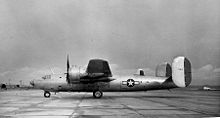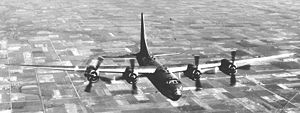Consolidated B-32
The Consolidated B-32 Dominator (dt. Ruler) Consolidated Model 34 was a heavy four-engine bombers of the United States Army Air Forces in World War II . It was designed according to the same specifications as the Boeing B-29 Superfortress and built parallel to it.
Only a few machines reached the units in the Pacific in the summer of 1945. Until the atomic bombs were dropped on Hiroshima and Nagasaki, only a few missions were flown. The orders were canceled after the end of the war, a total of 118 machines had been built.
history
The development of the B-32 was started on a tender of the United States Army Air Corps from January 1940, in addition also the Boeing XB-29, the Lockheed XB-30 and the Douglas XB-31 participated. Although the Boeing model won the tender after Lockheed and Douglas voluntarily retired, the Army Air Corps wanted to protect itself in the event that problems would arise with the favored XB-29 and ordered two XB-29s in addition to it in August 1940 additionally two prototypes of the XB-32.
The Consolidated Model 33 was initially similar to the Consolidated B-24 , it had an H-shaped twin tail unit and Davis wings with high aspect ratio . However, the fuselage had a round cross-section and a rounded nose with greater length. The drive consisted of four 2,200 hp Wright R 3350 duplex cyclone engines. The cockpit was designed as a pressurized cabin , 15 remote-controlled machine guns of caliber 12.7 mm formed the defense armament. The maximum flight weight should be 45,814 kg. The first AC-15549 contract was signed on September 6, 1940 and provided for two XB-32-CO machines. On the same day the contract AC-15429 for the construction and delivery of the Boeing B-29 was signed.
The first XB-32-CO (AAF s / n 41-141) suffered from massive problems with the pressurized cabin, the remote-controlled weapon stands and the chassis flaps. The inner motors were of the R-3350-13 type, while the R-3350-21 type was used for the two outer motors. Recurring problems with the engine cooling and oil leaks delayed the first flight. Already six months behind schedule, the XB-32-CO took off for the first time on September 7, 1942. The Boeing B-29 made its maiden flight on September 21, 1942.
On March 17, 1943, 300 machines of the type B-32-CF were ordered. The first XB-32 crashed on May 10, 1943 after 30 flights. The second machine (s / n 41-142) flew for the first time on July 2, 1943. After extensive inspections and tests, the USAAF has now requested a number of changes.
The second XB-32 was equipped with eight 12.7 mm machine guns in the fuselage as well as two 20 mm cannons in each outer engine nacelle. The problems with the pressurized ventilation of the cabin were not resolved, nor were those of the malfunctioning remote-controlled arms. The armament was changed to ten 20 mm cannons and the bomb load increased to 9,072 kg.
Stability problems became apparent on the second XB-32 . To remedy these difficulties, the machine was provided with the modified rear of a B-29; however, this was not satisfactory. A third prototype (s / n 41-18336) flew with a vertical tail unit newly developed by Consolidated on November 3, 1943 (the series machines were then delivered again with the tail unit of the B-29). Subsequent models of this type were given the model number 34.
In 1944 the USAAF ordered over 1,500 B-32s . The first series machine was delivered on September 19, 1944. The Boeing B-29 was already fully operational in India at this point . In December 1944 only five B-32 machines were delivered. The B-29 was already flying from the Mariana Islands to Japan . On January 27, 1945, 40 unarmed B-32-5, -10 and -15 were delivered as training bombers.
Originally, the B-32 was designed as a replacement design to secure the Boeing B-29 project. However, after the development of the B-32 itself became more and more delayed, this task became obsolete. Due to the success of the Boeing B-29, plans to replace the Boeing B-17 and Consolidated B-24 machines on the 8th and 15th in the Pacific after the end of the war in Europe no longer came to fruition . US air fleet provided by type B-32 machines . This task was now performed by the Boeing B-29.
Mission history
General George Kenney called for more B-29 bombers in the Southwest Pacific. Since his wishes were rejected in Washington, he switched to the B-32 . Three B-32s came to Luzon in the Philippines from mid-May 1945 . After a test phase, the B-24 and Douglas A-20 of two squadrons of the 312th Bomb Group were to be replaced by B-32 machines. During the test flights up to June 17th, one was impressed by the high loading capacity, the reverse thrust of the inner propellers and the Davis wings. However, the engine noise in the cockpit reached an extreme level, the flight instruments were poorly positioned and there were frequent engine fires.
Three B-32s were assigned to the 386th Bomb Squadron of the 312th Bomb Group. These three B-32 bombers flew their first use on May 29, 1945 against a supply depot in Antatet in the Philippines. On June 15, 1945 two B-32s dropped sixteen 907 kg bombs at a sugar mill in Taito, Formosa, and on June 22, two B-32s bombed an alcohol factory in Heito, Formosa, with 227 kg bombs. On June 25, a bridge near Kiirun on Formosa was attacked. The test flights were mostly successful and the B-32 was intended to replace the B-24. Another six missions were flown by the end of the war.
The highest number of units in the USAAF was in August 1945 at 62 B-32, of which 53 in the USA and 9 in use in the Pacific region. From there the aircraft was withdrawn until October 1945. By April 1946 there were no longer any B-32s in the USAAF inventory.
Air fight despite Japanese surrender
On August 13, 1945, the machines were moved to Okinawa for photo reconnaissance . Despite Japan's surrender on August 15, 1945, fourteen Mitsubishi A6M Zero and Nakajima Ki-44 Tojo attacked two B-32 photo reconnaissance aircraft on August 18, 1945 . The B-32-CF Dominator "Hobo Queen II" (s / n 42-108532) suffered severe damage, Sergeant Anthony J. Marchione was killed during this mission. He was the last to be killed in aerial combat during World War II. The US forces were then instructed to dismantle the propellers of all Japanese machines they could get hold of.
The last use as a photo reconnaissance aircraft for the 386th Bomb Squadron took place on August 28, 1945. On September 8, 1945, production of the B-32 was stopped and on October 12, it was finally discontinued.
After the end of the hostilities, a total of 38 mostly almost brand-new machines were transferred directly from the manufacturer to the Kingman Airport aircraft cemetery for recycling and immediately scrapped.
Built versions
| Version (CO: Consolidated San Diego Plant CF: Fort Worth Plant) |
number |
|---|---|
| XB-32-CO | 3 |
| B-32-1-CF | 10 |
| B-32-5-CF | 4th |
| B-32-20-CF | 20th |
| B-32-21-CF | 1 |
| B-32-25-CF | 25th |
| B-32-30-CF | 7th |
| B-32-35-CF | 7th |
| TB-32-5-CF | 11 |
| TB-32-10-CF | 25th |
| TB-32-15-CF | 4th |
Fort Worth delivered 114 aircraft of the 118 B-32s (1944: 14, 1945: 100) and San Diego supplied 4 aircraft (2 each in 1944 and 1945). The first aircraft were taken over in August 1944, the last in August 1945. The aircraft cost $ 790,433 each, significantly more than the more powerful B-29 ($ 605,360).
Technical specifications
| Parameter | Data |
|---|---|
| length | 25.3 m |
| span | 41.2 m |
| Wing area | 132.1 m² |
| height | 10.1 m |
| Empty mass | 27,000 kg |
| Flight mass | 45,000 kg |
| drive | four double radial engines Wright R-3350 -23 Cyclone with 2,200 PS (1,600 kW) each |
| Top speed | 575 km / h |
| Range | 1,300 km |
| Service ceiling | 10,670 m |
| crew | ten |
| Armament |
|
literature
- Superfort back-up (Plane Facts). In: AIR International February 1979, p. 93 u. 95
Web links
Individual evidence
- ↑ Statistical Digest of the USAF 1946, p. 127, p. 141
- ↑ Statistical Digest of the USAF, 1945, p. 114, p. 123 f .; 1946, p. 119



